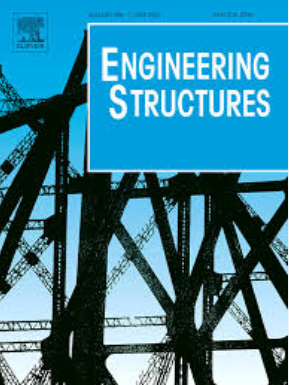考虑风致疲劳的输电塔线系统台风脆弱性分析
IF 5.6
1区 工程技术
Q1 ENGINEERING, CIVIL
引用次数: 0
摘要
在台风易发地区,建筑物易受台风荷载的影响。与季风相比,台风的风速和湍流强度更大,导致结构更容易产生风致疲劳。疲劳损伤引起的材料性能退化使塔体更容易失效,严重影响输电线路的安全运行。现有的输电塔风致疲劳分析研究忽略了台风的影响。为此,本文提出了考虑台风和季风引起的风致疲劳的输电塔线系统台风脆弱性分析方法,并通过对上海某输电塔线系统脆弱性的分析,说明了该方法的应用过程。首先,收集上海市历史风速和风向数据并进行分类,分别建立台风和季风风速和风向的联合概率分布模型;然后,对塔线体系进行了风致疲劳分析,计算了构件在台风和季风双重荷载作用下的疲劳损伤。随后,在材料退化模型的基础上,建立了不同服役时间下的疲劳损伤有限元模型。最后,进行了台风作用下塔线系统的易损性分析,研究了风致疲劳损伤对输电线路台风易损性的影响。结果表明,风致疲劳损伤显著增加了台风作用下输电塔线系统的失效概率,在疲劳分析中不可忽视台风的影响。该分析方法为台风易发地区结构性能评价提供了另一种途径。本文章由计算机程序翻译,如有差异,请以英文原文为准。
Typhoon fragility analysis of transmission tower-line system considering wind-induced fatigue
In typhoon-prone areas, structures are vulnerable to typhoon loads. Compared to monsoon, the wind speed and turbulence intensity of typhoon are larger, which leads to structures being more prone to wind-induced fatigue. The degradation of material properties caused by fatigue damage makes towers more likely to fail, which seriously affects the safe operation of transmission lines. The existing researches on wind-induced fatigue analysis of transmission towers ignore the influence of typhoon. Therefore, this paper proposed a typhoon fragility analysis method of transmission tower-line systems considering wind-induced fatigue caused by typhoon and monsoon, and illustrated the application process through analyzing the fragility of a transmission tower-line system in Shanghai. Firstly, the historical wind speed and wind direction data in Shanghai were collected and categorized, and the joint probability distribution models of wind speed and direction for typhoon and monsoon were established, respectively. Then, the wind-induced fatigue analysis of the tower-line system was conducted to calculate fatigue damage caused by combined typhoon and monsoon loads of members. Subsequently, based on the material degradation model, the finite element models with fatigue damage in different service times were developed. Finally, the fragility analysis of the tower-line system subjected to typhoon was performed, and the influence of wind-induced fatigue damage on typhoon fragility of transmission lines was studied. The results revealed that wind-induced fatigue damage significantly increased the failure probability of transmission tower-line systems subjected to typhoon, and the influence of typhoon should not be ignored in fatigue analysis. This analysis method provides another approach for evaluating the structural performance in typhoon-prone areas.
求助全文
通过发布文献求助,成功后即可免费获取论文全文。
去求助
来源期刊

Engineering Structures
工程技术-工程:土木
CiteScore
10.20
自引率
14.50%
发文量
1385
审稿时长
67 days
期刊介绍:
Engineering Structures provides a forum for a broad blend of scientific and technical papers to reflect the evolving needs of the structural engineering and structural mechanics communities. Particularly welcome are contributions dealing with applications of structural engineering and mechanics principles in all areas of technology. The journal aspires to a broad and integrated coverage of the effects of dynamic loadings and of the modelling techniques whereby the structural response to these loadings may be computed.
The scope of Engineering Structures encompasses, but is not restricted to, the following areas: infrastructure engineering; earthquake engineering; structure-fluid-soil interaction; wind engineering; fire engineering; blast engineering; structural reliability/stability; life assessment/integrity; structural health monitoring; multi-hazard engineering; structural dynamics; optimization; expert systems; experimental modelling; performance-based design; multiscale analysis; value engineering.
Topics of interest include: tall buildings; innovative structures; environmentally responsive structures; bridges; stadiums; commercial and public buildings; transmission towers; television and telecommunication masts; foldable structures; cooling towers; plates and shells; suspension structures; protective structures; smart structures; nuclear reactors; dams; pressure vessels; pipelines; tunnels.
Engineering Structures also publishes review articles, short communications and discussions, book reviews, and a diary on international events related to any aspect of structural engineering.
 求助内容:
求助内容: 应助结果提醒方式:
应助结果提醒方式:


